Servings
6Prep
30 minCook
16 hrTonkotsu Broth
- 4 pounds pork feet, cut to expose bone marrow
- 6 eggs
- 1/4 cup soy sauce
- 2 tablespoons mirin
- 2 tablespoons sake
- 1 tablespoon sugar
We spent Thanksgiving this year in Japan which was probably my favorite Thanksgiving spent anywhere! Not only did I absolutely love traveling through the county and eating all of their amazing food, but I’ve never been much of a fan of Thanksgiving as is. We don’t even properly celebrate it at home because no one in my family likes turkey, I don’t think fruit has any business near meat unless it’s a charcuterie board, and what are marshmallows doing melting on top of my sweet potatoes? I’ve never quite understood it, and that’s why every year we always just make a prime rib and invite friends over.
We also don’t have any immediate or even extended family in the area so Thanksgiving has always just be me, my mom and my dad…. and any friends we can wrangle up. So I didn’t feel so bad this year not making it, my parents don’t care if I come home on a holiday or the weeks before or after, as long as I make it back every few months. So when we saw a chance to fly to Japan for super cheap, we booked it immediately!
I’m a ramen girl, and I knew the best bowl of ramen I had ever had was in Osaka. I was determined to eat as much ramen as I could on that trip, while also eating as much curry, tonkatsu, tsukemen, sushi… and pretty much everything else. When we were on our final train ride back, Jimmy announced to our group that he was going to come home and learn how to make ramen, real ramen, not just pre-made broths and noodles. This was our first shot and it came out way better than expected! We’ll be going on a ramen creating journey, finding out how to make the clearest broth, the more flavorful tare, and the best chashu and everything in between. Be warned though, if you’re looking to make your own ramen, this is a day long adventure so you might want to start on the weekend, when you can leave your stove on for an entire day straight.
——
I think we need to start by explaining that your soup is made up of two parts, the broth and the tare. The broth which in this case is 100% pork bones (tonkotsu) is where you’re going to pull the depth of flavor out of your bones. On it’s own, you’re not getting any of the salty or spicy components you often associate with ramen. Many ramen shops though make one broth, and that’s the base for every bowl on their menu. If you really think about, it takes 16+ hours to simmer, so you really have to plan ahead. Now, the tare is actually where you’re getting most of the distinctive flavor from. You’re probably already familiar with the concept, when you order shio ramen (salt), shoyu ramen (soy) or miso ramen. Essentially what you’re ordering is the ramen shops base broth, mixed with the type of flavoring that you want. Below we’re going to start with a pure tonkotsu broth.
Start by adding your pork feet, to a large stock pot and filling it with water 1-2 inches above the bones. You’ll want to boil the bones for 15 min, stirring occasionally. Foamy sentiment will rise to the top and by boiling it, it’ll be easy to remove all the junk from inside them.
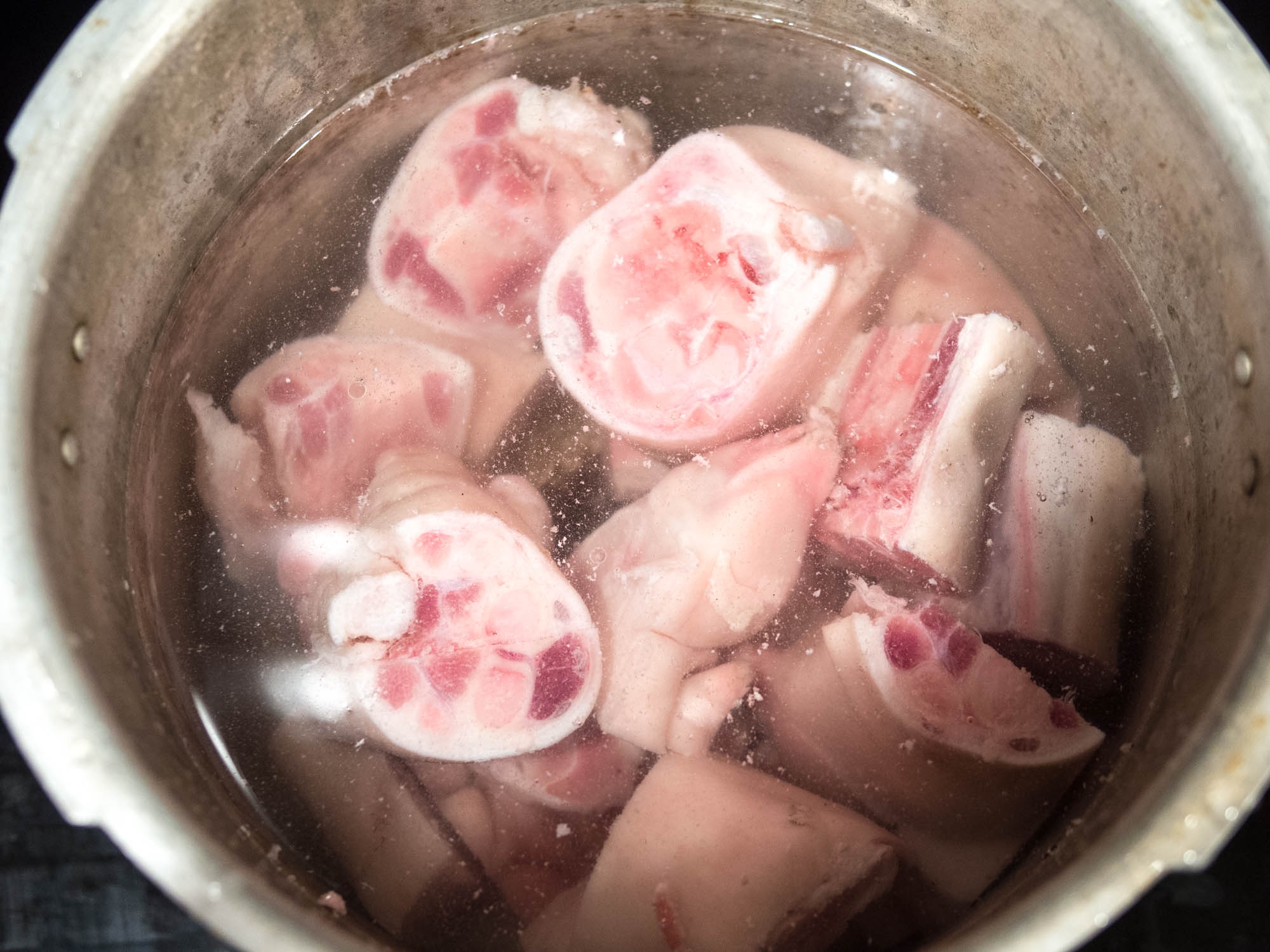 With a needle, tap lightly to poke a small hole into the larger end of the egg. This is going to allow the extra gas to escape the egg while it’s boiling. You don’t want weird shaped eggs do you? Of course not, you’re a ramen master!
With a needle, tap lightly to poke a small hole into the larger end of the egg. This is going to allow the extra gas to escape the egg while it’s boiling. You don’t want weird shaped eggs do you? Of course not, you’re a ramen master!
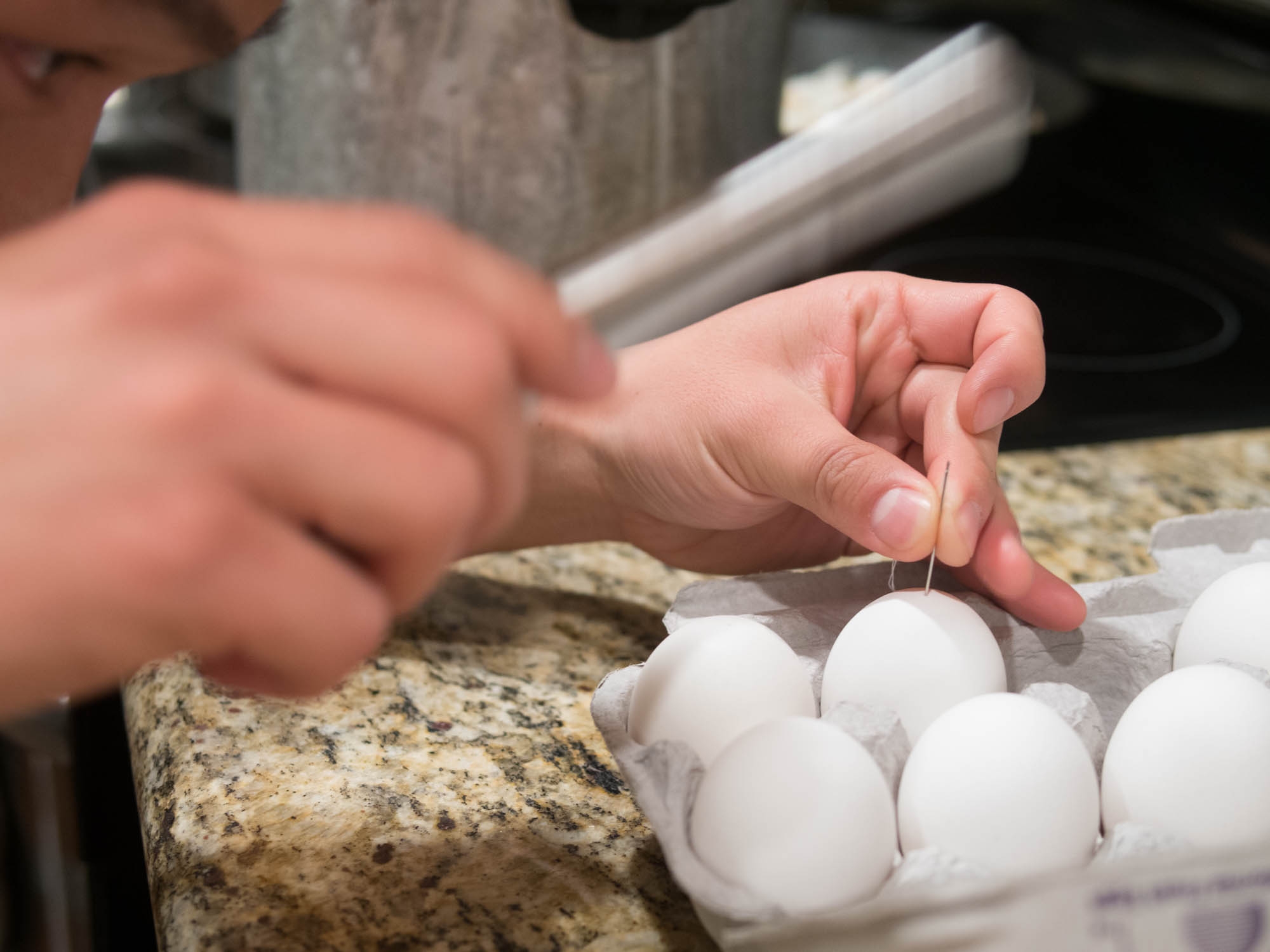
When you notice your pot boiling up with what looks like a cloud of brown gunk, remove it from the heat, strain the bones and you’re ready to clean. We use the end of a chopstick (the thinner the better) to scrape out the marrow and everything else. You’re aiming for bare bones here, the more you leave on the bones, the less clear your broth will be. You can even go at the bones with a toothbrush if you really want to get at every last little piece.
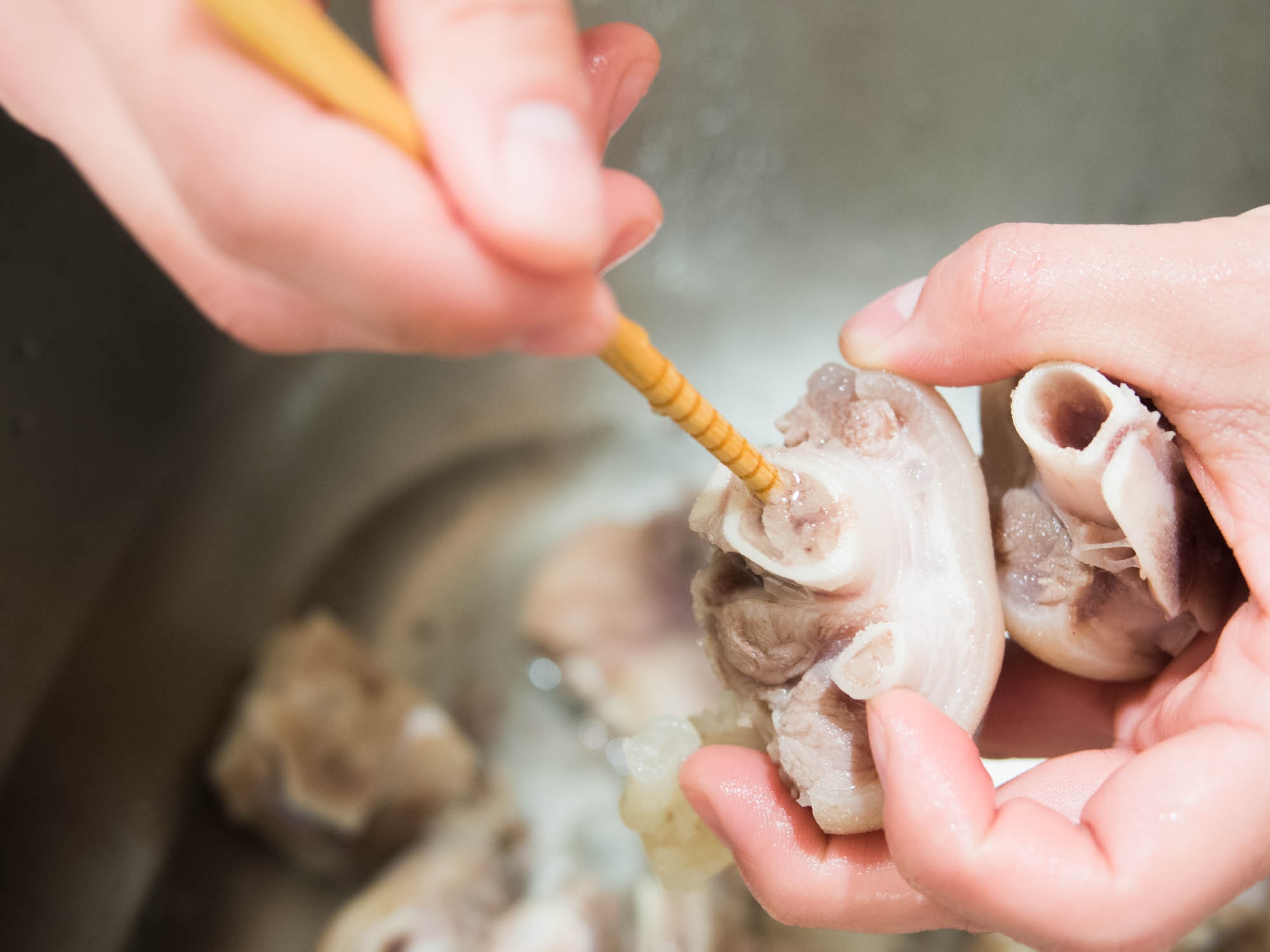
Place back in the pot and add water a few inches above the bones. Bring it to a rolling boil and reduce down to a simmer for a minimum of 16 hours.
Boil eggs for 7 minutes and 30 seconds and then gently drop them into an ice bath. This will make sure that your eggs have that creamy goodness inside instead of becoming hard boiled. When completely cool, gently crack the shell off the eggs.
Put the soy sauce, mirin, sake, and sugar into a bowl big enough for all of your eggs. Soak a paper towel in the marinade and drape on top of the eggs. Doing this keeps your eggs from floating up and not soaking in the marinade evenly. Allow this to sit in your fridge for minimum 4 hours, up to 12 hours, flipping the eggs once midway through.
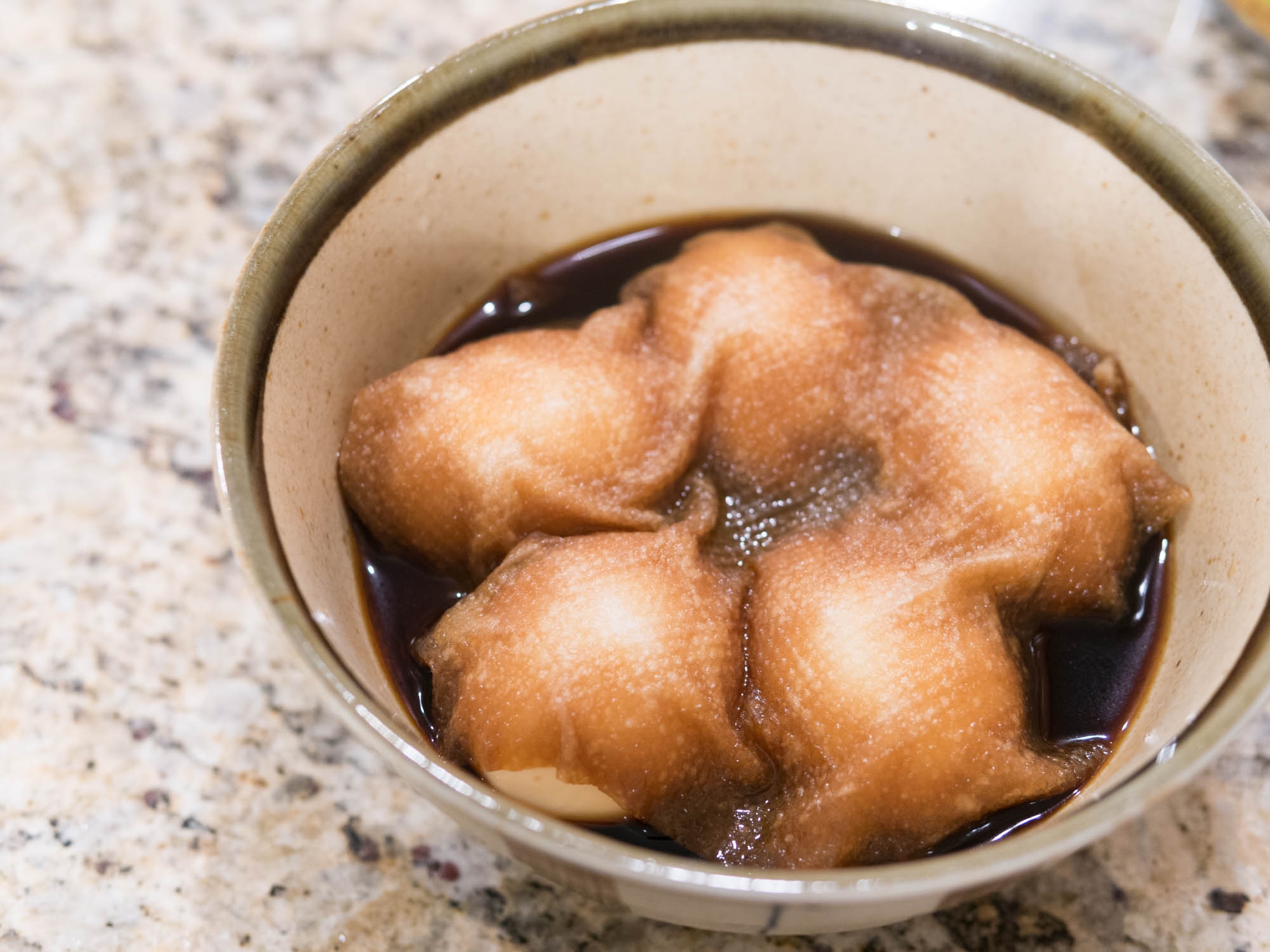
Using a piece of thread or floss, hold the egg from one end and slice the eggs in half. Don’t use a knife!
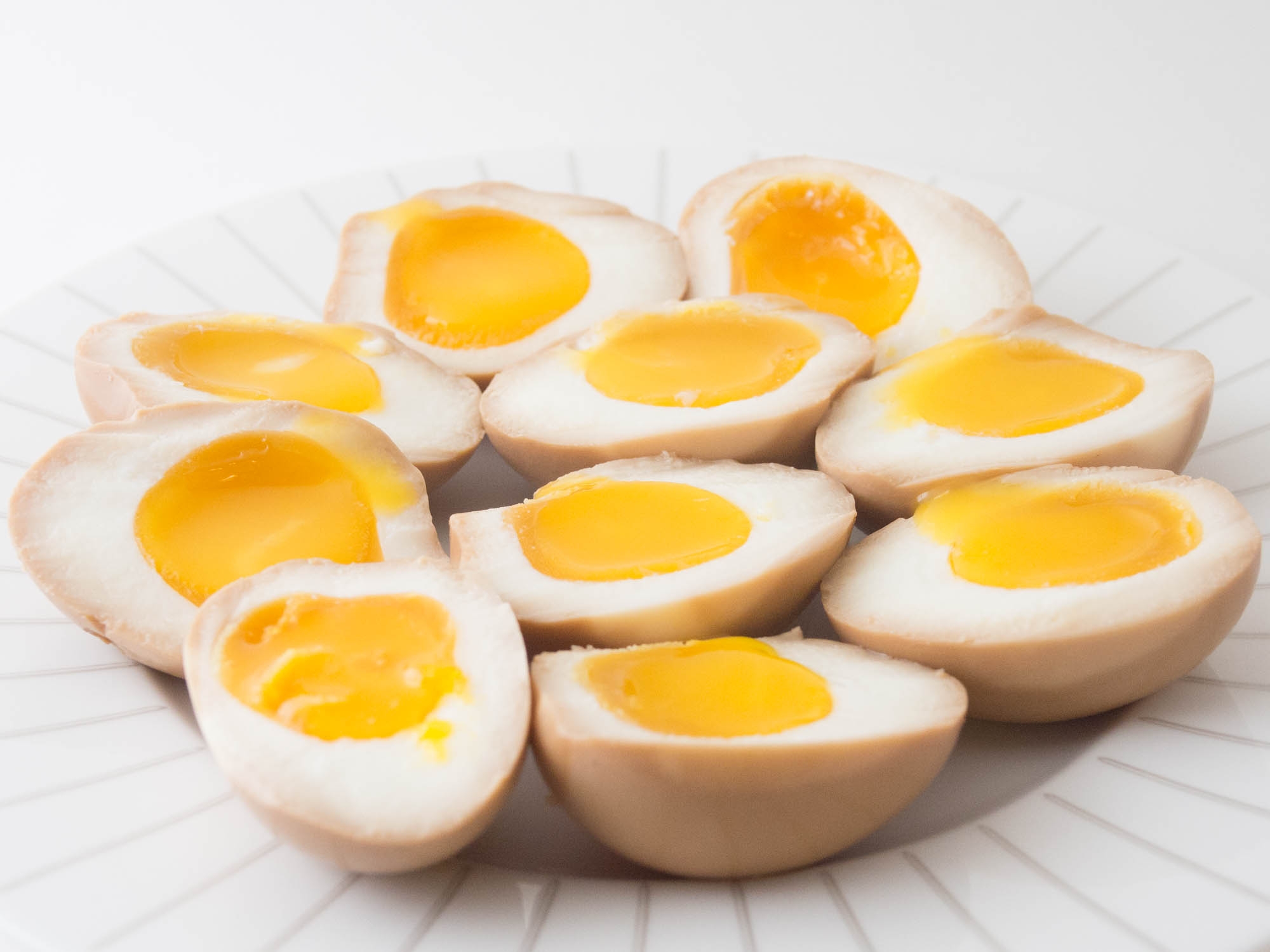
Chashu Pork
- 2 pounds pork shoulder
- 1/2 cup soy sauce
- 1 cup mirin
- 1 cup sake
- 1/4 cup sugar
- 6-8 garlic cloves, crushed
- 4-5 green onions
- 2 inch piece ginger, peeled and sliced
- 2 small shallots, halved
Preheat the oven to 250°F.
Place all of the ingredients in a large, heavy-bottomed, oven safe pot and bring to a gentle boil over medium heat. When the mix comes to boil, cover with the lid and place in the oven and cook for minimum 4 hours, up to 6, flipping pork occasionally. The pork should be super tender.
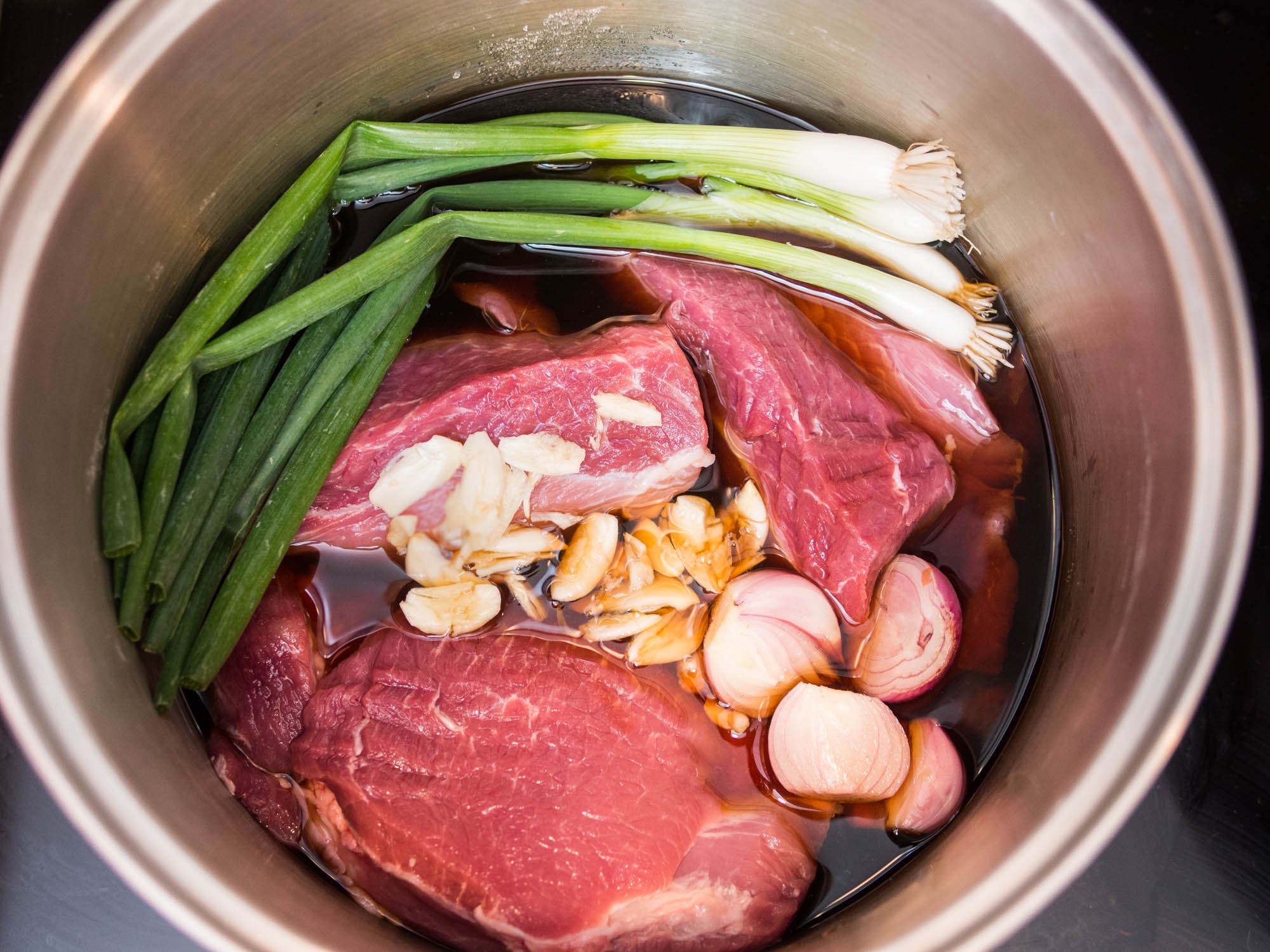
Remove the pork from the sauce and, gently slice.
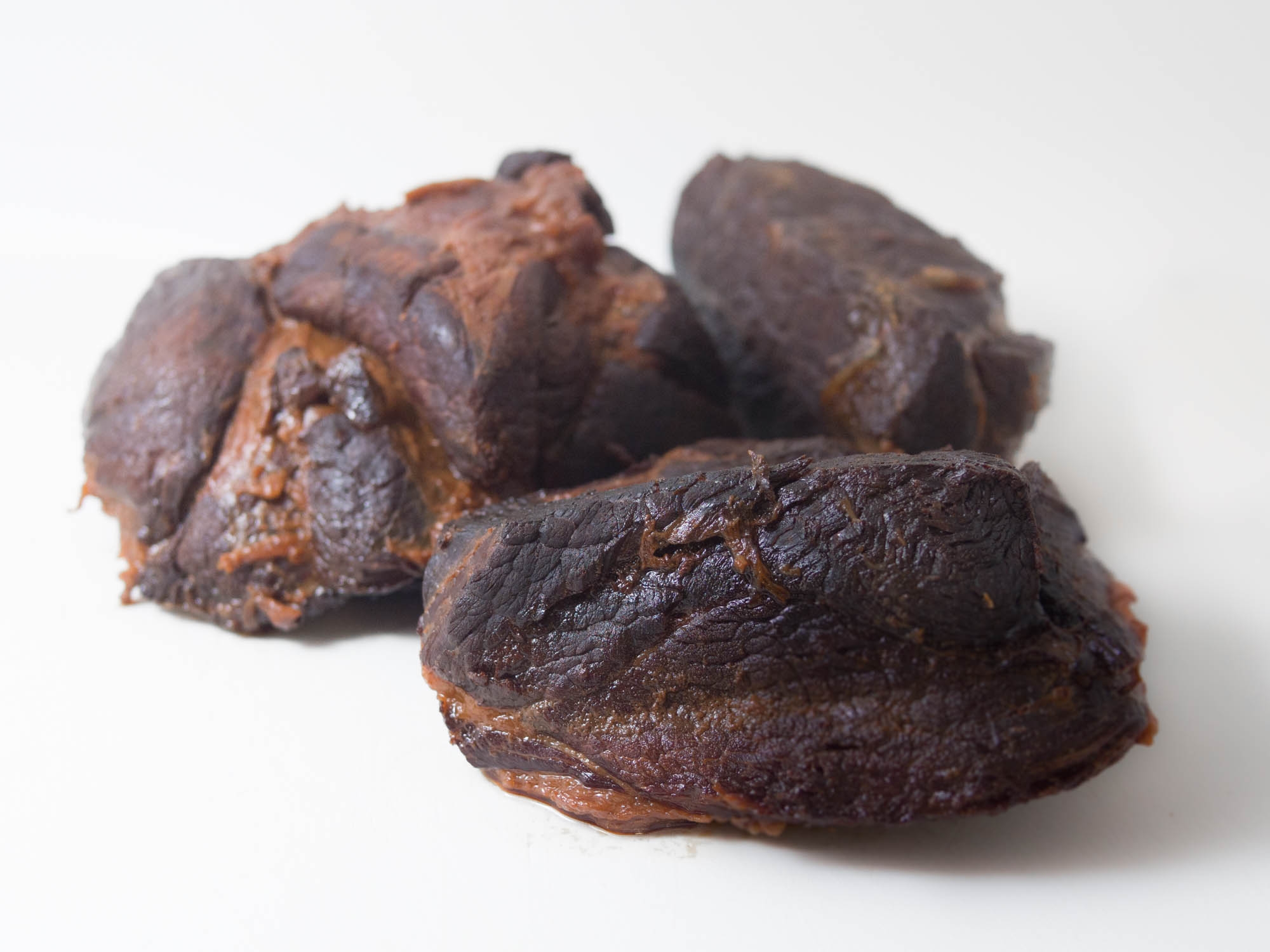
Serve atop as a topping for above ramen. You can also save any leftovers and serve over rice with green onion or on a bun. Reserve the liquid to use as sauce over noodles or rice, if desired.
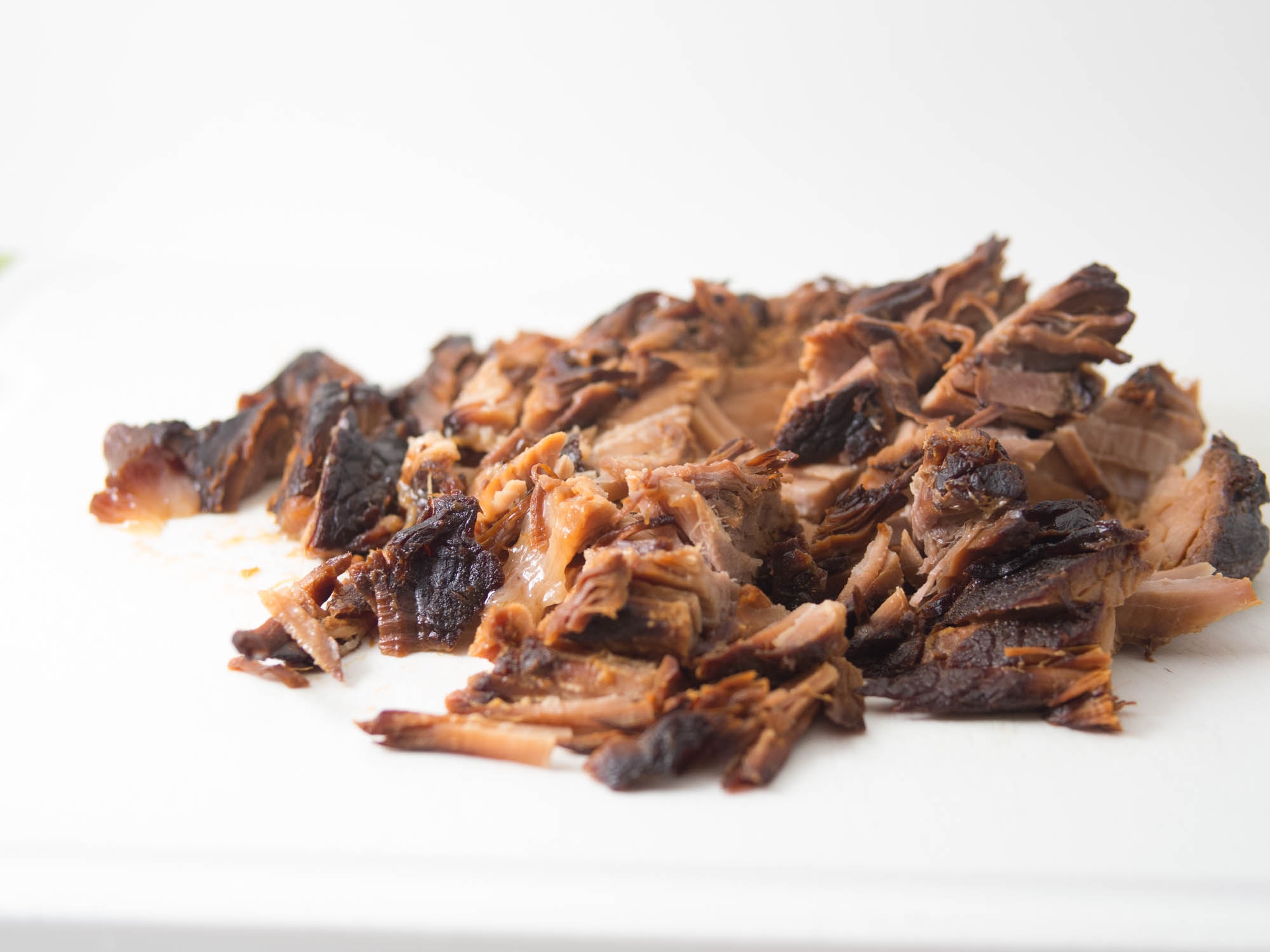
Tare (Shio)
- 2 tablespoons sea salt
- 2 tablespoons sake
- 1 tablespoon mirin
- 2 teaspoons sesame oil
- 1 teaspoon soy sauce
- 1 garlic clove, crushed
Creating the tare is really about making it however you want to make it. I realize this might seem incredibly unhelpful if you’re here on the blog trying to learn how to make ramen and here I am telling you to figure it out on your own. What I mean by this is, this is where you can decide if you want it to be simple but salty, fatty and spicy, and really just build up the umami.
For this bowl, we went with a shio ramen, keeping things simple but flavorful. Mix together all of the ingredients of the tare and then start by adding a spoonful to the bottom of each individual bowl. Add the broth and season with more tare accordingly.
Boil ramen noodles for 2 and a half minutes, add all your toppings on, serve and enjoy!
NOM!
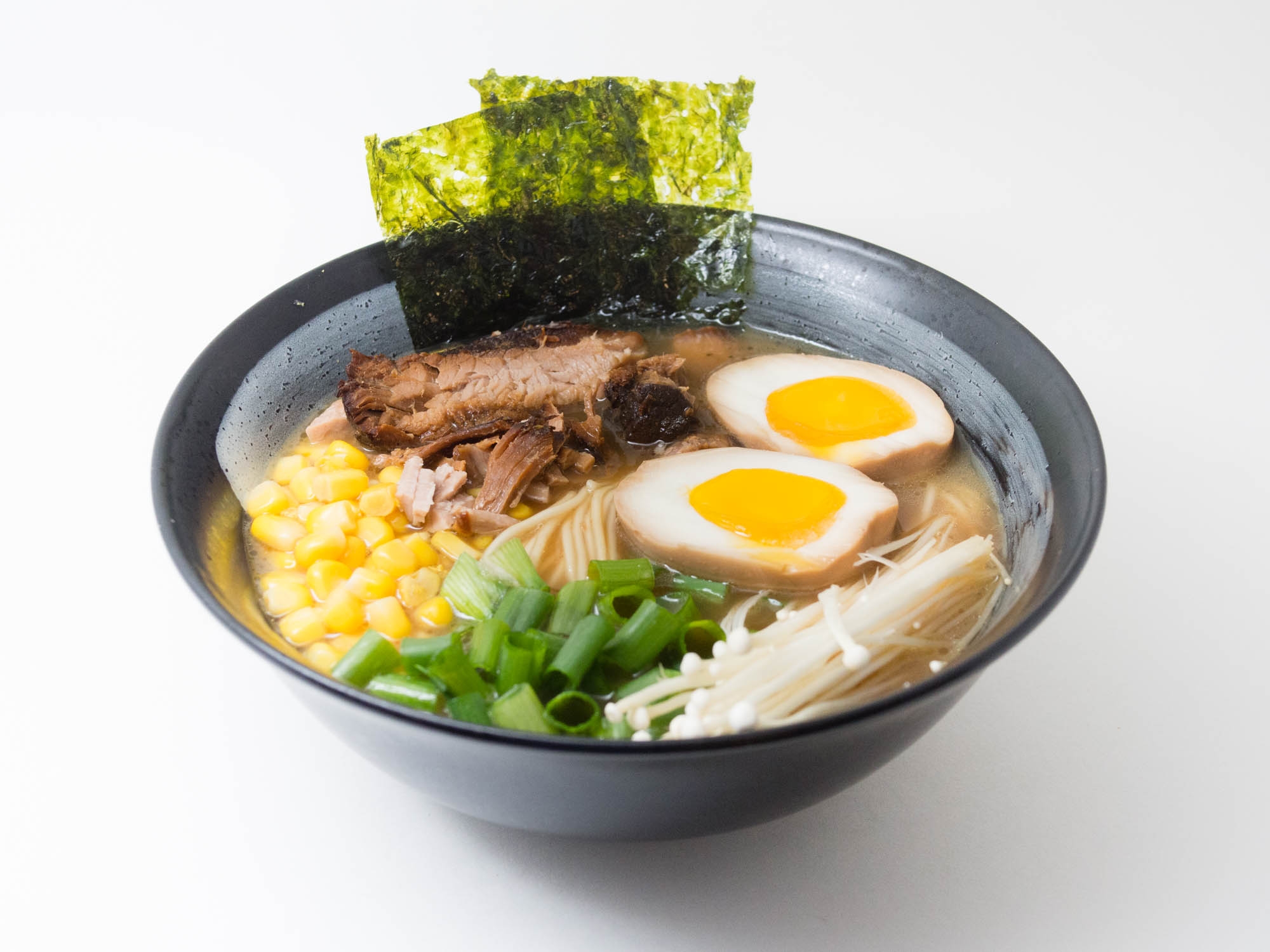 ‘
‘

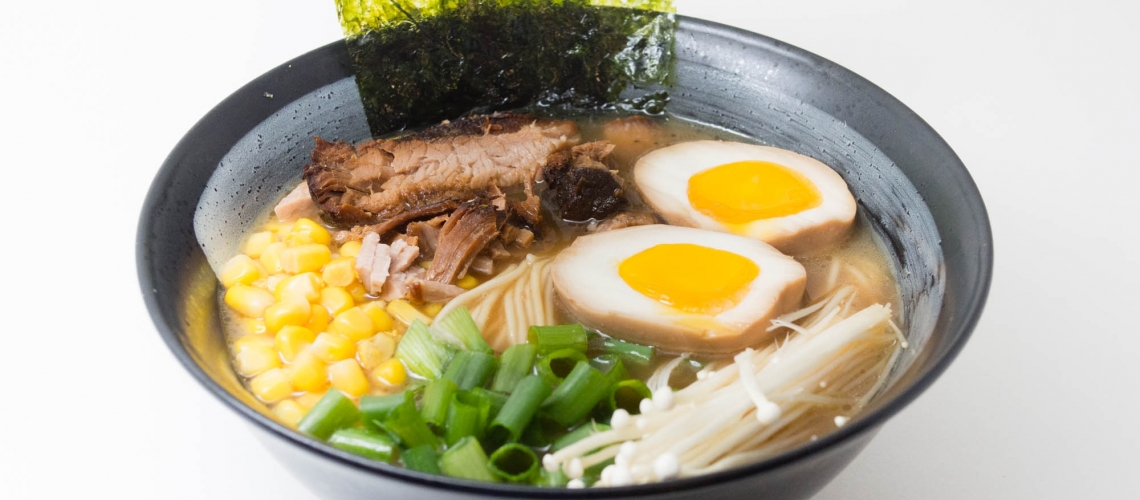
 Mint Mustard Rack of Lamb
Mint Mustard Rack of Lamb Sea Salt Chocolate Chip Cookies
Sea Salt Chocolate Chip Cookies




Yum! Looks amazing. I am going to give it a go tonight/tomorrow. Have you tried any other broth bases yet?
No yet, but we plan to and once we do it’ll be up on the blog so check back!
Update: it was sooooo good! Making it again tonight. Thanks so much for the post!
Glad to hear it!
looks good! at what stage do you add the enoki mushrooms? is it possible to also add fresh shitake?
All of the toppings are added at the end by placing them on top. You can absolutely add fresh shiitake instead, though I would even recommend sauteing them with some light salt until browned to get some of the moisture out and bring out the flavor.
Have you guys tried making the broth with pressure cooker?
Great post. Thank you. I have been comparing a few different recipes for the Tare for Tonkotsu ramen. I wanted to combine your recipe with another I found. I would like to add dried bonito flakes and dried anchovy as well. Will this just add to the Umani, or would it be to over the top.
Thanks
Hi Nick – Sorry for the massive delay, I went on a bit of a hiatus >.< Depends on how much you're using there, I feel like bonito flakes would be less aggressive, and the anchovies could even be fine, I would just be careful in how much you use. Honestly the best method is trying it out and figuring out your preference. The beauty about tare is that you can play around with two or three or as many different recipes since you just add your broth after, it's not like you have to commit the entire dish to the seasoning 🙂
I’m so grateful for this recipe! Thank you so much! I made mine with a miso tare– delicious.
I have a question though:
When prepping the pigs feet, do you have any more tips and tricks for how to get them “cleaner”? My tonkotsu was cloudy, and when left for even 15 minutes off a rolling boil, it developed a thin gelatinous layer on top. I know this is big no-no at ramen restaurants. I chalked it up to not cleaning enough collagen from the bones, but…. oh boy… it was hard as is, and took me almost two hours to prep the feet! Maybe I don’t have the right tools or technique. Help!
Note: I ran out of sake, and used rice wine vinegar as a substitute in a little less qualities for the eggs. Still delicious!
Tare: I added a 1 1/2 tbsp red miso paste, and some gonchujang to taste.
Loaded it up with menma (bamboo shoots) on top too. My favourite.
Hi Stephanie – While this might not be it, I have found that getting proteins (and bones) from different markets can change the outcome due to the quality of meat that different stores get. I like to go to a Chinese grocer like 99 Ranch for bones because they’re always in stock and dirt cheap but know that sometimes it might not be the quality I want for something like cleaning bones. You can try asking at something like a Whole Foods, or a specialty grocer, or a butcher shop.
As for technique, we used a chopstick to clean but the smaller and sharper the tool the better to get in all the crevices. I’d also even recommend a hard toothbrush if that’s easier. Cloudiness, when the broth settles really only, sounds like there was still collagen on the bones. As a side note: while not aesthetically pleasing, still really good for your skin! So not the worst thing that can happen. Glad you enjoyed it!
Hi! Should the tonkotsu be covered during the 16 hours? Thank you!
I prefer it covered to keep anything from the outside world out, but it won’t change the outcome if you cover it or keep it uncovered.
Thanks For Sharing this amazing recipe. My family loved it. I will be sharing this recipe with my friends. Hope the will like it.